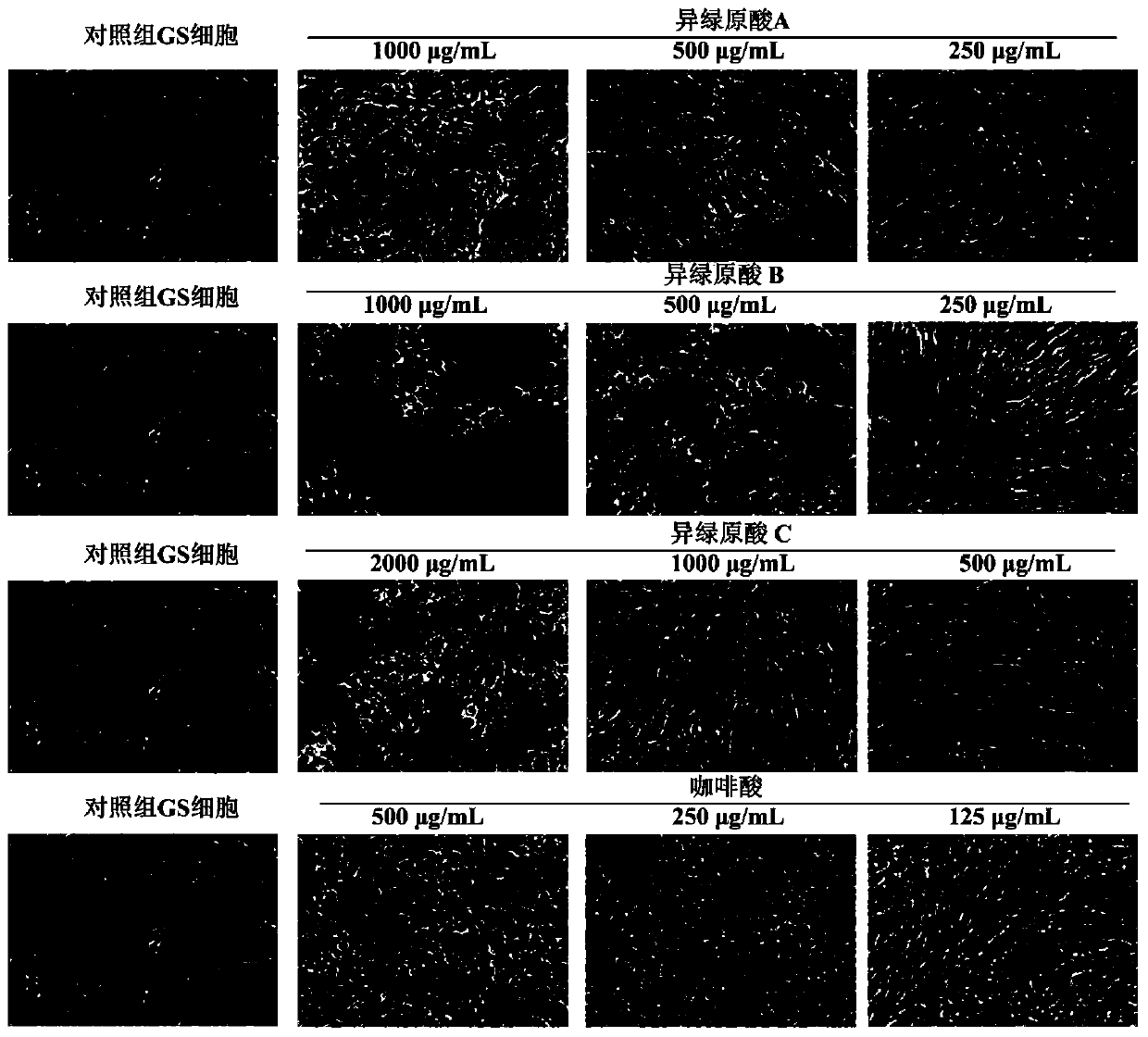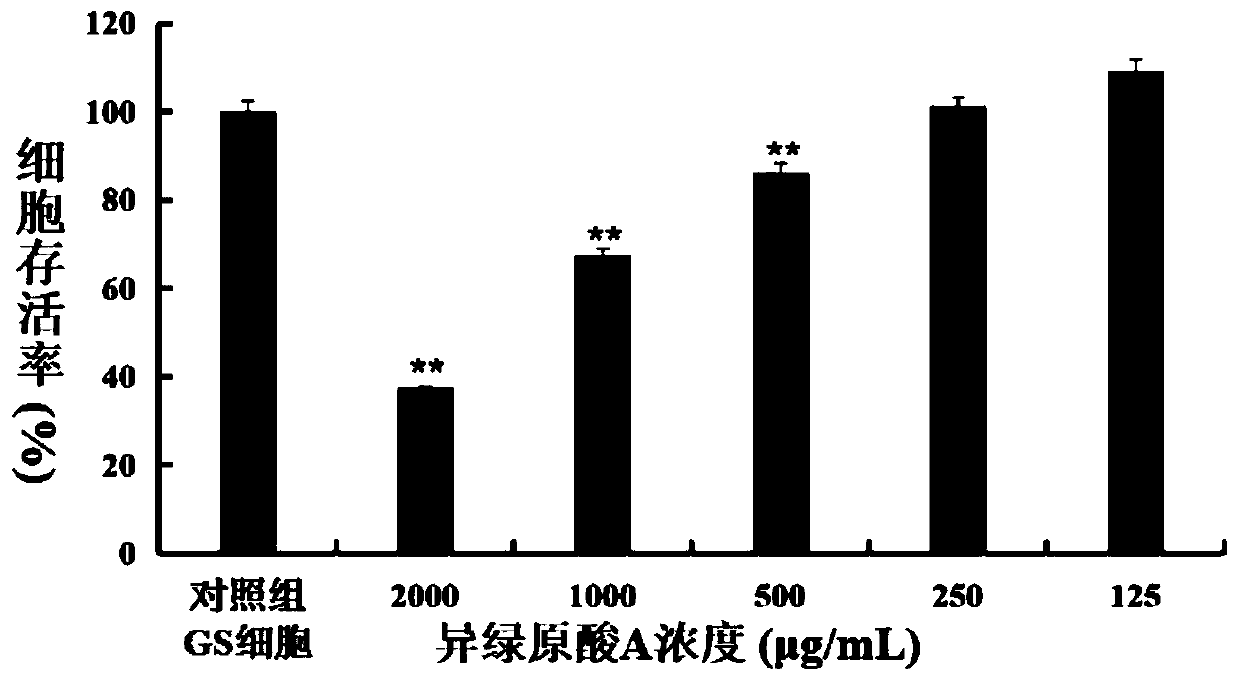Organic acid inhibitor resistant to fish disease, and preparation method and application thereof
An organic acid and inhibitor technology, which is applied in the field of organic acid inhibitors against fish diseases and its preparation, can solve the problems of no drugs available, and achieve the effects of reducing drug residues, improving production efficiency, and reducing dosage
- Summary
- Abstract
- Description
- Claims
- Application Information
AI Technical Summary
Problems solved by technology
Method used
Image
Examples
Embodiment 1
[0033] 1. Main instruments and reagents
[0034] Optical microscope.
[0035] 2. Experimental method
[0036]GS cells were introduced into 96-well plates at the number of 10,000 / well, cultured at 28°C for 24 hours, and then the four plant sources of isochlorogenic acid A, isochlorogenic acid B, isochlorogenic acid C and caffeic acid Compound monomers were diluted to different concentrations in cell culture medium (isochlorogenic acid A: 1000, 500, 250 μg / mL; isochlorogenic acid B: 1000, 500, 250 μg / mL; isochlorogenic acid C: 2000, 1000, 500 μg / mL; caffeic acid: 500, 250, 125 μg / mL); in the experimental group, different concentrations of isochlorogenic acid A, isochlorogenic acid B, isochlorogenic acid C and caffeic acid were mixed with 96 wells The GS cells in the plate were incubated at 28°C for 48 hours, and the cell morphology was observed with a light microscope. The control group in this experiment was GS cells without adding the above-mentioned plant-derived compound ...
Embodiment 2
[0040] 1. Main instruments and reagents
[0041] Microplate reader, 5-(2,4-disulfophenyl)-3-(2-methoxy-4-nitrophenyl)-2H-tetrazole sodium inner salt solution (WST-8 solution).
[0042] 2. Experimental method
[0043] GS cells were introduced into 96-well plates at the number of 10,000 / well, cultured at 28°C for 24 hours, and then the four plant sources of isochlorogenic acid A, isochlorogenic acid B, isochlorogenic acid C and caffeic acid Compound monomers were set to different concentrations in the cell culture medium (isochlorogenic acid A: 2000, 1000, 500, 250, 125 μg / mL; isochlorogenic acid B: 2000, 1000, 500, 250, 125 μg / mL; Isochlorogenic acid C: 2000, 1000, 500, 25, 125 μg / mL; caffeic acid: 2000, 1000, 500, 250, 125, 62.5 μg / mL); different concentrations of plant-derived compound monomers were mixed with 96 wells The GS cells in the plate were incubated at 28°C for 48h. In order to detect cell viability, 20 μL of WST-8 solution was added to the cells in each well to ...
Embodiment 3
[0049] 1. Main instruments and reagents
[0050] Real-time fluorescent quantitative PCR technology (qRT-PCR).
[0051] 2. Experimental method
[0052] Dilute isochlorogenic acid A, isochlorogenic acid B, isochlorogenic acid C and caffeic acid in the cell culture medium and set to different concentrations (isochlorogenic acid A: 250, 125, 62.5 μg / mL; isochlorogenic acid B: 250, 125, 62.5 μg / mL; isochlorogenic acid C: 500, 250, 125 μg / mL; caffeic acid: 125, 62.5, 31.25 μg / mL) plant compound monomer solution, The RT-qPCR technique was used to detect the effect of the plant compound monomer solution prepared in this example on inhibiting grouper iridescent virus infection under different concentration conditions. The GS cells were introduced into a 24-well plate at a quantity of 40,000 / well, and cultured at 28°C for 24 hours. The plant compound monomer solution to be tested was mixed with SGIV-Gx virus (10 5 TCID 50 / mL) were added to the cells in a 24-well plate and incubat...
PUM
 Login to View More
Login to View More Abstract
Description
Claims
Application Information
 Login to View More
Login to View More - R&D
- Intellectual Property
- Life Sciences
- Materials
- Tech Scout
- Unparalleled Data Quality
- Higher Quality Content
- 60% Fewer Hallucinations
Browse by: Latest US Patents, China's latest patents, Technical Efficacy Thesaurus, Application Domain, Technology Topic, Popular Technical Reports.
© 2025 PatSnap. All rights reserved.Legal|Privacy policy|Modern Slavery Act Transparency Statement|Sitemap|About US| Contact US: help@patsnap.com



